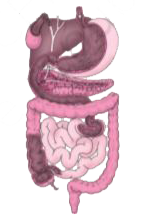Non-enzymatic digestive juice is saliva/Bile.
To determine which of the two digestive juices, saliva or bile, is non-enzymatic, we can follow these steps:
1. Identify the Source of Each Digestive Juice:
- Saliva is produced in the mouth by three major salivary glands: the parotid glands (located in the cheeks), submandibular glands (located in the lower jaw), and sublingual glands (located below the tongue).
- Bile is produced by the liver and stored in the gallbladder.
2. Examine the Composition of Saliva:
- Saliva is composed of water, electrolytes, mucus, and enzymes, specifically salivary amylase.
- Salivary amylase is an enzyme that breaks down starch into maltose, indicating that saliva has enzymatic activity.
3. Examine the Composition of Bile:
- Bile contains bile pigments (bilirubin and biliverdin), bile salts, phospholipids, and cholesterol.
- Importantly, bile does not contain any digestive enzymes.
4. Determine the Function of Each Digestive Juice:
- The primary function of saliva is to initiate the digestion of carbohydrates through the action of salivary amylase.
- The main function of bile is to emulsify fats, which increases the surface area for fat-digesting enzymes (like lipase) to act, but bile itself does not contain these enzymes.
5. Conclusion:
- Since bile does not contain any enzymes, it is classified as a non-enzymatic digestive juice. In contrast, saliva contains the enzyme salivary amylase, making it enzymatic.
Final Answer:
Bile is the non-enzymatic digestive juice.
---
- Saliva is produced in the mouth by three major salivary glands: the parotid glands (located in the cheeks), submandibular glands (located in the lower jaw), and sublingual glands (located below the tongue).
- Bile is produced by the liver and stored in the gallbladder.
- Saliva is composed of water, electrolytes, mucus, and enzymes, specifically salivary amylase.
- Salivary amylase is an enzyme that breaks down starch into maltose, indicating that saliva has enzymatic activity.
- Bile contains bile pigments (bilirubin and biliverdin), bile salts, phospholipids, and cholesterol.
- Importantly, bile does not contain any digestive enzymes.
- The primary function of saliva is to initiate the digestion of carbohydrates through the action of salivary amylase.
- The main function of bile is to emulsify fats, which increases the surface area for fat-digesting enzymes (like lipase) to act, but bile itself does not contain these enzymes.
- Since bile does not contain any enzymes, it is classified as a non-enzymatic digestive juice. In contrast, saliva contains the enzyme salivary amylase, making it enzymatic.
Bile is the non-enzymatic digestive juice.
Topper's Solved these Questions
- DIGESTION AND ABSORPTIONBOOK - MODERN PUBLICATIONCHAPTER - DIGESTION AND ABSORPTIONEXERCISE - REVISION EXERCISES (Very Short Answer Questions)
30 Videos
- DIGESTION AND ABSORPTIONBOOK - MODERN PUBLICATIONCHAPTER - DIGESTION AND ABSORPTIONEXERCISE - REVISION EXERCISES (Short Answer Questions)
35 Videos
- DIGESTION AND ABSORPTIONBOOK - MODERN PUBLICATIONCHAPTER - DIGESTION AND ABSORPTIONEXERCISE - QUICK MEMORY TEST (B. Complete the missing links)
14 Videos
- CHEMICAL COORDINATION AND INTEGRATIONBOOK - MODERN PUBLICATIONCHAPTER - CHEMICAL COORDINATION AND INTEGRATIONEXERCISE - Chapter Practice Test
16 Videos
- EXCRETORY PRODUCTS AND THEIR ELIMINATIONBOOK - MODERN PUBLICATIONCHAPTER - EXCRETORY PRODUCTS AND THEIR ELIMINATIONEXERCISE - Chapter Practice Test
12 Videos
Similar Questions
Knowledge Check
Bile juice is:
AalkalineBacidicCneutralDnear acidicAssertion: Bile is not a true digestive juice
Reason: Bile lacks digestive enzymes.AIf both assertion and reason are true and reason is the correct explanation of assertionBIf both assertion and reason are true but reason is not the correct explanation of assertion.CIf assertion is true but reason is false.DIf both assertion and reason are false.Assertion :- Bile is not a true digestive juice.
Reason:- Bile juice lacks digestive enzymes.AIf both assertion and reason are true and reason is the correct explanation of assertion.BIf both assertion and reason are true but reason is not the correct explanation of assertion.CIf assertion is true but reason is false.DIf both assertion and reason are false.
Pancreas || digestive juices || saliva || gastric juice || succus entericus || bile || pancreatic juice || physiology || carbohydrate || protein || fat || nucleic acid digestion
View SolutionWhat is the importance of digestive juices in digestive system?
View SolutionWhat is the importance of digestive juices in digestive system ?
View Solution
Label the following parts in Figure 2.2 and name them.
(a) The largest gland in our body.
(b) The organ where protein digestion starts.
(c ) The organ that releases digestive juice into the small intestine.
(d) The organ where bile juice gets stored.
View SolutionOne of the digestive juices that lacks enzyme but aids in digestion is ……………………………
View Solution
